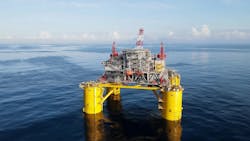OTC 2023: Shell discusses how its Vito project adapted to a changing marketplace
Bruce Beaubouef * Managing Editor
HOUSTON – Shell’s Vito project came onstream in the deepwater Gulf of Mexico this past February, but the final field layout and production facility had to go through significant evolution and adaptation following the market crash of 2014.
That was the theme of the presentation “Vito: Finding Opportunity Through Adaption and Resiliency,” jointly offered by Kurt Shallenberger, Vito Project Manager, Shell International Exploration and Production Inc., and Eirik Sorgard, Project Business Opportunity Manager, Shell Exploration & Production Co. on Tuesday at the Offshore Technology Conference in Houston.
Originally discovered in 2009, Shallenberger and Sorgard said that the company had originally planned on developing Vito along the lines of its Appomattox project, which involved a much larger production platform and field layout. “We were following the same path,” said Sorgard. But after 2014, it was clear that “this path [was] not sustainable. It was ‘back to the drawing board.’”
There had to be a culture and perspective change, toward “competitive and affordable.” To achieve buy-in throughout the staff and supply chain, “we had to make emotional connections,” Shallenberger said. The new theme throughout was “advancing deepwater together.”
One key aspect here was “humility,” Shallenberger added. “We had to be willing to learn from others in the industry, and use their lessons learned to minimize project scope.” Through this rethinking, Shell found that while it needed to focus on safety, there were some redundancies and capabilities that were not strictly necessary. “We had to take some prudent risks,” said Sorgard. “Not on safety but sometimes on efficiency.”
“We operated with the philosophy that simpler is safer and more cost effective,” said Shallenberger. “We would start with a minimum scope and then justify additions based on value.”
Starting in 2015, Shell conducted a roughly three-year redesign exercise from the subsurface up. The company succeeded in reducing the capex estimate by more than 70% from the original concept. This was achieved in several ways: reduced well count, improvements in drilling efficiency, a smaller, fit for purpose FPS with limited spare capacity, and competitively bid fabrication. As an example of how the Vito project got “leaner,” the original plans had called for a 40,000 mt platform. After the redesign, the final weight of the Vito platform is 8,500 mt, with an operating weight of 9,500 mt.
In addition, the leaner FPS design incorporated automation technology that reduced manning significantly. With this development plan, Shell estimated that they could develop Vito for a forward-looking breakeven price less than $35 per boe.
“We also asked ourselves: how can we take advantage of existing infrastructure,” Sorgard said. By connecting into the nearby Olympus platform, Shell could move the produced crude oil and gas economically into existing systems. In fact, he added, “it was important that we looked not only at our own project but the entire Mars Corridor.” It was in that vein that the installation of new pumps on Shell’s West Delta 143c platform helped keep crude oil flowing from the Vito field, and kept the footprint on the Vito topsides lean.
Shell will apply lessons learned from Vito on Whale, its next deepwater Gulf of Mexico project. The Whale FPS hull will be a 99% replication of Vito, while the topsides will be an 80% replication of Vito. “Some changes will be needed,” Sorgard said, noting that since Whale is further offshore, it will need larger helicopters to transport workers and material, which in turn will necessitate a larger helo-deck. Different subsurface geology will also necessitate some changes. But Shell plans to re-use many of the same vendors and owners team, which should lead to “a lower footprint and lower greenhouse gas impact.”
05.02.2023
About the Author
Bruce Beaubouef
Managing Editor
Bruce Beaubouef is Managing Editor for Offshore magazine. In that capacity, he plans and oversees content for the magazine; writes features on technologies and trends for the magazine; writes news updates for the website; creates and moderates topical webinars; and creates videos that focus on offshore oil and gas and renewable energies. Beaubouef has been in the oil and gas trade media for 25 years, starting out as Editor of Hart’s Pipeline Digest in 1998. From there, he went on to serve as Associate Editor for Pipe Line and Gas Industry for Gulf Publishing for four years before rejoining Hart Publications as Editor of PipeLine and Gas Technology in 2003. He joined Offshore magazine as Managing Editor in 2010, at that time owned by PennWell Corp. Beaubouef earned his Ph.D. at the University of Houston in 1997, and his dissertation was published in book form by Texas A&M University Press in September 2007 as The Strategic Petroleum Reserve: U.S. Energy Security and Oil Politics, 1975-2005.

